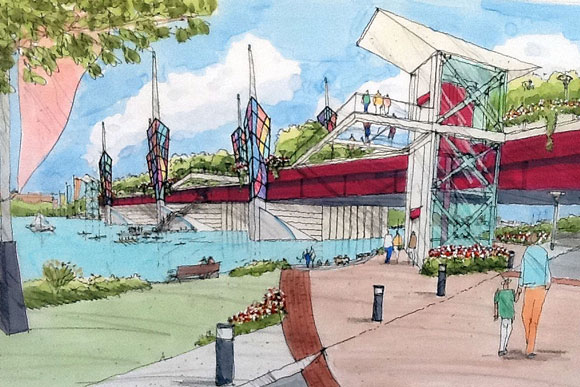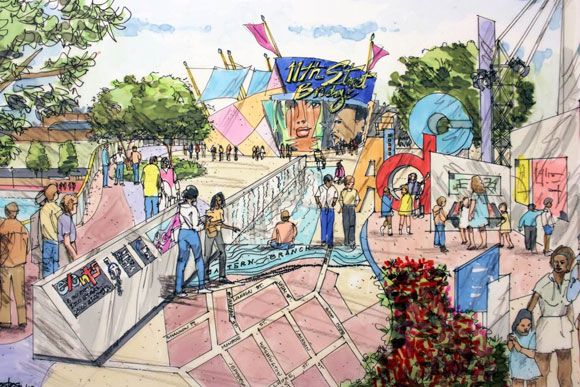The plan for a park over the Anacostia River is inching from plan to reality.
At a meeting Tuesday at the Kaiser Permanente Center for Total Health,
11th Street Bridge Park director Scott Kratz announced that the project has kicked off its design competition and raised $800,000 of its $1 million pre-campaign goal.
The project started as a crazy idea just over two years ago. The 11th Street bridge connecting Navy Yard to Anacostia was (and is) being rebuilt. The old piers for the outdated span remain in the water.
What if, then-planning director Harriet Tregoning asked Kratz over breakfast, what if we reused the old pillars to create a new park?
The park would cross the Anacostia adjacent to the new, car-and-bike-and-pedestrian-transporting span. It would link booming Navy Yard with historic Anacostia, perhaps bringing some of the amenities found west of the river to the east. It would be D.C.'s
High Line, the city's own example of taking out-of-date infrastructure and turning it into something useful.
"[Tregoning] had this idea, and asked if I was interested in helping," Kratz said Tuesday. "Maybe I should have had another cup of coffee, and said, 'Wait a minute,' but I said 'Sure, you bet.'"
He's since quit his job at the National Building Museum to work full-time on this project, which would be the first of its kind in D.C. and one of the first in the country.

In addition to creating a literal bridge to bring residents from each side of the river together, the project aims to create a space for healthy living, which was the focus of Tuesday's meeting. The general principle is clear: Having a safe, welcoming place for active recreation can be good for health.
Meeting attendees brainstormed ways to make the park more friendly for active life. Should the park host a 5K run? Build a dog park or a skate park? Host a regular farmer's market? Maybe the park will install a human-powered art piece, or a
bikeometer to track the number of cyclists. Kayaks and canoes for visitors to check out the river are another key element.
Nothing's off the table yet, Kratz told Elevation DC. Space constraints will mean they can't incorporate
every idea, but even that's not too much of a problem. "The engineering studies suggest you could cantilever out to 120 feet wide," he said. The bridge, freed of the constraints that come from having to accommodate cars and trucks, could swoop up or dive down to the river. The available space, hypothetically, is as big as three football fields laid end to end.
The park has the potential to bring not just health and wellness but prosperity to residents on both sides of the river. The High Line in New York, which the city paid $115 million toward to convert the abandoned elevated rail tracks to a park, generated $2 billion dollars in economic activity in its first two years. Much of that was from increased rents at buildings near the High Line, which raises its own issues. The 11th Street Bridge Park's own economic impact study is due out later this month. It will address, among other things, said Kratz, "What are the best ways we can keep the dollars from this in our community?" The answers to that question will go a long way toward making sure all residents benefit from the park.
It will not be easy. Even though stakeholders from the city to the National Capital Planning Commission to the National Parks Service have given their blessing to the plan, Kratz estimates the park must raise $35 million to build the park and pay for its continued maintenance and programming.

And there are smaller, logistical issues to address. A proposed streetcar stop on the 11th Street Bridge could provide access to the park once it opens, but for those arriving by Metro? A study by Virginia Tech Masters of Planning students marks large swaths of the pedestrian routes from the Anacostia and Navy Yard metro stops as "uninteresting," "uncomfortable," or "unsafe." Still, these aren't dealbreakers, just challenges to be overcome.
If all goes well, the bridge could open as early as 2017.
Til then, Kratz is continuing to spread the word at community meetings (over 200 so far) and raising money...and planning a bike parade along both banks of the river for the 2015 Cherry Blossom festival, to raise awareness of the project and attract people to the river. Think decorated bikes all up and down both sides of the Anacostia, art installations, maybe boats. "I can close my eyes," he said, "and picture that bike parade."